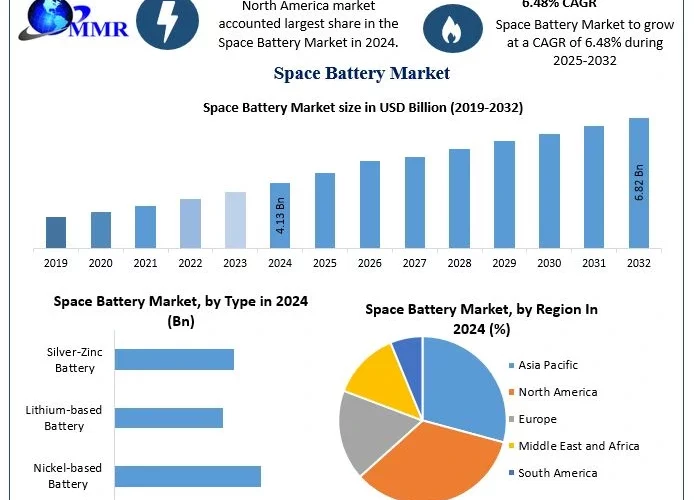Introduction
The space industry is booming like never before. Satellites, space exploration missions, and space stations all require reliable and efficient power sources to operate. This is where the space battery market plays a critical role. Space batteries power everything from small satellites to huge space stations, ensuring continuous energy supply in the harsh conditions of outer space. Understanding the current market, its growth, and future outlook helps investors, engineers, and companies plan better for the expanding space sector. In this article, we will explore the key insights into the space battery market, the factors driving its growth, and what the future holds till 2030.
What Are Space Batteries?
Space batteries are specialized energy storage devices designed to work in space environments. Unlike regular batteries, they must endure extreme temperatures, radiation, and long mission durations without failing. Common types include lithium-ion, nickel-hydrogen, and emerging solid-state batteries. These batteries store energy generated by solar panels or other sources and release it steadily to power spacecraft systems, communication devices, and scientific instruments.
Rise of the Space Battery Market
Over the last decade, satellites, spacecraft, and lunar rovers have demanded more reliable power sources, driving rapid growth in the space battery market. Early missions used simple nickel‑cadmium cells, but modern projects—from small CubeSats to crewed vehicles—need higher energy density and longer lifespans. As both government agencies and private companies ramp up launches, investment in advanced lithium‑ion and solid‑state batteries has surged, turning space power systems into a booming industry.
Market Insights
1. Current Market Size and Value
The global space battery market is growing steadily, driven by increasing investments in satellite launches, space exploration missions, and space tourism. As of 2025, the market size is estimated to be valued at over $1 billion, and it is expected to grow at a strong compound annual growth rate (CAGR) of around 8-10% through 2030.
2. Key Market Segments
- By Battery Type: Lithium-ion batteries dominate due to their lightweight, high energy density, and reliability. Nickel-hydrogen batteries still hold a place in some satellite applications. New solid-state batteries are emerging for enhanced safety and performance.
- By Application: Space batteries are used in satellites (communication, weather, GPS), space stations, space probes, and launch vehicles. Satellite applications make up the largest share of the market.
- By Region: North America, especially the USA, leads the market due to its strong space programs and private space companies. Europe and Asia-Pacific regions are also growing rapidly.
3. Major Players in the Market
Leading companies include Tesla, Panasonic, Saft Groupe, BYD, and Johnson Controls. These companies invest heavily in research and development to create batteries that last longer and perform better in space conditions.
Benefits of Advanced Space Batteries
Next‑generation batteries offer clear gains for space missions. They store more energy in less weight, extending mission duration without adding launch costs. Improved thermal stability and radiation resistance keep systems safe in harsh space environments. Longer cycle life reduces the need for replacements on orbit, saving repair costs and risks. These benefits let satellites run more instruments, support longer interplanetary trips, and ensure critical systems—like life support and communication—stay powered without fail.
Role of Batteries in Space Systems
Batteries act as the backbone of any spacecraft’s power network. During sunlight, solar arrays charge the battery bank; when the vehicle enters Earth’s shadow or deep space, batteries power all onboard electronics. They support everything from navigation computers and sensors to docking systems and scientific payloads. In crewed missions, batteries also handle peak power draws—like thruster firings or habitat climate control—making them essential for both routine operations and emergency backups.
Factors Driving Market Growth
1. Increased Satellite Launches
The surge in satellite launches, especially small and nano satellites, creates high demand for space batteries. These satellites need reliable power systems to operate smoothly.
2. Space Exploration and Missions
Government agencies like NASA, ESA, and private players like SpaceX and Blue Origin are planning more space missions, requiring batteries that can perform in deep space and harsh environments.
3. Technological Advancements
Advances in battery technology, such as solid-state batteries and improvements in lithium-ion chemistry, are enhancing battery life, energy density, and safety.
4. Rise of Space Tourism
As companies plan space tourism, spacecraft need safe and efficient batteries to ensure passenger safety and mission success.
5. Government Funding and Policies
Supportive government policies and funding for space research encourage development and adoption of advanced battery technologies.
Challenges Facing the Space Battery Market
- High Costs: Manufacturing and testing space-grade batteries is expensive. The high costs can limit adoption, especially for smaller players.
- Technical Complexity: Designing batteries that withstand extreme temperature swings and radiation without degradation is challenging.
- Safety Concerns: Battery failures in space can be catastrophic, so safety standards are extremely strict, which can slow innovation.
- Supply Chain Issues: Raw materials like lithium and cobalt are limited and can face supply chain disruptions.
Future Outlook and Trends till 2030
1. Growth of Solid-State Batteries
Solid-state batteries, which use solid electrolytes instead of liquids, promise higher energy density and better safety. They are expected to gradually replace lithium-ion batteries in space applications by 2030.
2. Integration with Renewable Energy
Hybrid systems combining solar panels and advanced batteries will improve efficiency and mission durations.
3. Reusable Spacecraft Power Systems
Batteries designed for reusable rockets and spacecraft will become more common, reducing mission costs.
4. Miniaturization and Lightweight Designs
Smaller, lighter batteries that pack more power will support the booming small satellite market.
5. Artificial Intelligence and Battery Management
AI-based battery management systems will optimize energy use and extend battery life in space.
Impact of Market Growth
The expanding space battery market will have ripple effects in many sectors:
- Communication: Better power systems will improve satellite communications and global internet coverage.
- Scientific Research: Long-lasting batteries enable deeper space exploration and new discoveries.
- Defense: Military satellites and systems will benefit from reliable energy storage.
- Commercial Space Industry: Lower costs and better batteries will boost space tourism and private space missions.
Conclusion
The space battery market is on a strong growth path, driven by the expanding space industry and advances in battery technology. From powering satellites and space stations to enabling space tourism and exploration, these batteries are crucial for mission success. Despite challenges like high costs and technical complexity, innovations such as solid-state batteries and AI management systems promise a bright future. By 2030, the space battery market is expected to be larger, more advanced, and vital for humanity’s journey beyond Earth.












